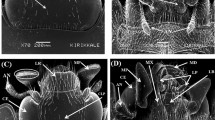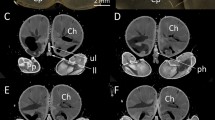Abstract
The mouthparts of unfed larvae of Platytrombidium fasciatum (C. L. Koch, 1836) and Camerotrombidium pexatum (C. L. Koch, 1837) (Acariformes: Microtrombidiidae) were studied using both light optical (whole-mounted specimens, toluidine blue stained semi-thin sections) and electron microscope (TEM, SEM) methods. The mouth apparatus incorporated within the gnathosoma occupies an axial position and is covered from above by the arched dorsal shield, or scutum. The chelicerae are comparatively long and separated, and the lateral lips form a permanent apomorphic sucker provided with an internal cuticular sclerite. The pharynx is extremely wide and totally fused with the bottom of the infracapitulum. The pharyngeal dilators originate on the posterior portions of the cervix (epistome) and on the capitular apodemes and run nearly parallel to the cervix to the dorsal pharyngeal wall. Comparatively short sigmoid pieces serve as origin of the muscles—cheliceral levators inserting on the posterior wall of the basal cheliceral segments. There are two sets of the extrinsic gnathosomal muscles originating on the posterior portion of the scutum: retractors of chelicerae inserting on the posterior portions of the basal cheliceral segments, and retractors of the gnathosoma inserting on the very posterior parts of the capitular apodemes. The labrum and the cervix delimit the pharynx and the subcheliceral space. The labrum and the cervix for the most part are weakly sclerotized cuticular plates and do not have own muscles. The larval mouth apparatus, in comparison with that of adult microtrombidiid mites, is simply organized and more specialized for ingestion of large masses of liquid food.









Similar content being viewed by others

References
Åbro A (1979) Attachment and feeding devices of water-mite larvae (Arrenurus spp.) parasitic on damselflies (Odonata, Zygoptera). Zool Scr 8:221–234
Akimov IA, Badanin IV (1999) Peculiarities of organization and function of the gnathosoma of some mites from the family Anystidae (Trombidiformes) (In Russian, with English summary). Vestn Zool 33:49–68
Akimov IA, Badanin IV, Wita I (2002) Some aspects of trophic specialization in both free-living and parasitic prostigmatid mites (Acari: Actinotrichida) from the morpho-functional viewpoint. Acarina 10:65–73
Alberti G, Coons LB (1999) Acari-Mites. In: Harrison FW (ed) Microscopic anatomy of invertebrates, vol 8. Wiley, New York, pp 515–1265
Alberti G, Crooker AR (1985) Internal anatomy. In: Helle W, Sabelis W (eds) Spider mites: their biology, natural enemies and control, vol 1A. Elsevier, Amsterdam, pp 29–62
André M (1927) Digestion “extra-intestinale” chez le Rouget (Leptus autumnalis Shaw). Bull Mus Nation Hist Nat 33:509–516
André HM, Remacle C (1984) Comparative and functional morphology of the gnathosoma of Tetranychus urticae (Acari: Tetranychidae). Acarologia 25:179–190
Badanin IV (2000) Functional morphology of the gnathosoma of mites Riccardoella oudemansi (Trombidiformes, Ereynetidae) (In Russian, with English summary). Vestn Zool 14:144–151
Baker JE, Connell WA (1963) The morphology of the mouthparts of Tetranychus atlanticus and observations on feeding by this mite on soybeans. Ann Ent Soc Am 56:733–736
Blauvelt WE (1945) The internal morphology of the common red spider mite (Tetranychus telarius Linn.). Mem Cornell Univ Agr Exp Sta 270:1–46
Böttger K (1969) Die Ernährumgsweise der Wassermilbe Limnochares aquatica (L.). Zool Anz 33:85–91
Brown JRC (1952) The feeding organs of the adult of the common “chigger”. J Morph 91:15–52
Davids C (1973) The water mite Hydrachna conjecta Koenike, 1895 (Acari: Hydrachnellae), bionomics and relation to species of Corixidae (Hemiptera). Netherl J Zool 23:363–429
De Lillo E, Di Palma A, Nuzzaci G (2001) Morphological adaptations of mite chelicerae to different trophic activities (Acari). Entomologica 35:125–180
Evans GO (1992) Principles of acarology. CAB International, Walingford, pp 563
Gabrys G, Wohltmann A, Makol J (2005) A redescription of Platytrombidium fasciatum (C.L. Koch, 1836), Atractothrombium sylvaticum (C.L. Koch,1835) (Acari: Parasitengona: Microtrombidiidae) with notes on synonymy, biology and life cycle. Ann Zool 55:477–496
Henking H (1882) Beiträge zur Anatomie, Entwicklungsgeschichte und Biologie von Trombidium fuliginosum Herm. Zeitschr wiss Zool 37:553–663
Hislop RG, Jeppson LR (1976) Morphology of the mouthparts of several species of phytophagous mites. Ann Ent Soc Am 69:1125–1135
Jones BM (1950) The penetration of the host tissue by the harvest mite, Trombicula autumnalis Shaw. Parasitology 40:247–260
Manton SM (1958) Hydrostatic pressure and leg extension in arthropods with special reference to arachnids. Ann Mag Nat Hist 1:161–182
Mathur SN, LeRoux EJ (1965) A description of the mouthparts and feeding mechanism of the velvet mite, Allothrombium lerouxi Moss (Trombidiformes: Trombidiidae). Ann Ent Soc Québec 10:33–61
Mitchell RD (1955) Anatomy, life history and evolution of the mites parasitizing fresh water mussels. Misc Publ Mus Zool Univ Michigan 89:1–41
Mitchell RD (1957) Major evolutionary lines in water mites. Syst Zool 6:137–148
Mitchell RD (1962a) The musculature of a trombiculid mite, Blankaartia acuscutellaris (Walch.). Ann Ent Soc Am 55:106–119
Mitchell RD (1962b) The structure and evolution of water mite mouthparts. J Morph 110:41–59
Mitchell RD (1964) The anatomy of an adult chigger mite Blankaartia ascoscutellaris (Walch.). J Morph 114:373–391
Newell JM (1958) Specific characters and character variants in adults and larvae of the genus Paratrombium Bruyant 1910 (Acari, Trombidiidae), with descriptions of two new species from Western North America. Pacific Sci 12:350–370
Newell JM, Tevis L Jr (1960) Angelothrombium pandorae n.g., n.sp. (Acari, Trombidiidae), and notes on the biology of the giant red velvet mites. Ann Ent Soc Am 53:293–304
Nuzzaci G, deLillo E (1991) Fine structure and functions of the mouth parts involved in the feeding mechanism in Tetranychus urticae Koch (Tetranychoidea: Tetranychidae). In: Dusbábek F, Bukva V (eds) Modern Acarology, 2nd edn. Academia, Prague and SPB Academic Publishing bv, The Hague, pp 301–306
Paran TP (1982) Functional morphology of the gnathosoma in Myobia musculi (Schrank, 1781) (Trombidiformes–Acari). Acarologia 23:347–357
Robaux P (1974) Recherches sur le developpement et la biologie des acariens “Thrombidiidae”. Mem Mus Natn Hist Nat (N.S.) Ser A Zool 85:1–186
Schmidt U (1935) Beiträge zur Anatomie und Histologie der Hydrachniden, besonders von Diplodontus despiciens O.F. Müller. Z Morph Ökol Tiere 30:99–176
Shatrov AB (1981) Morphological and functional peculiarities of the mouth parts in larvae of the chigger mite Neotrombicula pomeranzevi (Trombiculidae) (In Russian, with English summary). Parasitologiya 15:10–20
Shatrov AB (1985) Functional morphology of the mouthparts of deutonymphs and adults of the trombiculid mite Hirsutiella zachvatkini Schluger (Acariformes, Trombiculidae) (In Russian, with English summary). Entomol obozr 64:855–865
Shatrov AB (2000) Trombiculid mites and their parasitism on vertebrate hosts (In Russian, with extensive English summary). St.-Petersburg University Publishing, St.-Petersburg, 276 pp
Shatrov AB (2001a) Observations on external ultrastructural morphology of Trombidiid larvae (Trombidiidae, Microtrombidiidae). Acarina 9:149–162
Shatrov AB (2001b) On the ultrastructural and functional morphology of the mouthparts of trombidiid larvae (Acariformes: Trombidiidae). In: Buczek A, Blaszaka C (eds) Stawonogi Pasozyty i Nosiciele. Widawnictwo KGM, Lublin, pp 9–17
Shatrov AB (2004) Comparative organization of the salivary gland complex in unfed larvae, adult mites of Platytrombidium fasciatum (C.L. Koch, 1836), Camerotrombidium pexatum (C.L. Koch,1837) Acariformes: Microtrombidiidae. Phytophaga 14:83–89
Shatrov AB (2005) Description of mouthparts in adult mites of Platytrombidium fasciatum (C.L. Koch,1836) (Acariformes: Microtrombidiidae) with a comparison of those of the larvae. Acarina 13:47–74
Snodgrass RE (1948) The feeding organs of Arachnida, including mites and ticks. Smiths Misc Coll 110:1–93
Southcott RV (1997) Revision of the larvae of Paratrombium (Acarina: Trombidiidae) of Australia and Papua New Guinea, with notes on life histories. Rec South Aust Mus 29:95–120
Summers FM, Witt RL (1971) The gnathosoma of Cheyletus cacahuamilpensis Baker (Acarina: Cheyletidae). Proc Ent Soc Wash 73:158–168
Summers FM, Gonzalez RRH, Witt RL (1973) The mouthparts of Bryobia rubrioculus (Sch.) (Acarina: Tetranychidae). Proc Ent Soc Wash 75:96–111
Vainstein BA (1963) Materials on biology and systematic of water mites (Hydrachnellae). III. Description of several larvae of the genus Eylais Latr., 1796 (In Russian). Trudy Inst Biol Int Waters 6(9):159–170
Vainstein BA (1966) Materials on biology and systematic of water mites (Hydrachnellae). VI. Larvae Limnesia and Hydrovolzia (In Russian). Trudy Inst Biol Int Waters 12(15):192–198
Vainstein BA (1976) Larvae and the system of water mites of the family Hydrachnidae Leach, 1815 (Acariformes). Trudy Inst Biol Int Waters 31(34):133–155 (In Russian)
Van der Hammen L (1980) Glossary of acarological terminology, vol 1. General terminology. Dr. W. Junk bv Publishers, The Hague, 244 pp
Wharton GW (1946) Observations on Ascoschöngastia indica (Hirst, 1915) (Acarinida: Trombiculidae). Ecol Monogr 16:151–184
Wharton GW (1954) Observations on the feeding of prostigmatid larvae (Acarina, Trombidiformes) on arthropods. J Wash Acad Sci 44:244–245
Witte H (1978) Die postembryonale Entwicklung und die funktionnelle Anatomie des Gnathosoma in der Milbenfamilie Erythraeidae (Acarina: Prostigmata). Zoomorphologie 91:157–189
Witte H (1991) The phylogenetic relationships within the Parasitengonae. In: Dusbábek F, Bukva V (eds) Modern acarology, vol 2. Academia, Prague and SPB Academic Publishing bv, The Hague, pp 171–182
Witte H (1998) On the internal organization of smaridid mites (Acari, Erythraeoidea), and on the role of organismal properties for determining the course of evolutionary change. In: Ebermann E (ed) Arthropod biology: contributions to morphology, ecology and systematics. Biosystematics and ecology series, Wien 14:245–289
Wohltmann A, Makol J, Gabrys G (2003) A description of larva of Camerotrombidium pexatum (C.L. Koch, 1837), C. rasum (Berlese, 1910) (Acari: Parasitengona: Microtrombidiidae) with notes on their active instars and remarks on biology and life cycle. Ann Zool 53:539–549
Zhavoronkova OD (1989) Structure of the gnathema and feeding of water mite Piona longipalpis Krendowsky, 1878 (Acariformes). Trudy Inst Biol Int Waters 56(59):200–214 (In Russian)
Zhavoronkova OD (1990) The morphology of the mouth apparatus, feeding of Limnochares aquatica (L., 1758) (Acariformes). Zool Zhurnal 69:55–60 (In Russian with English summary)
Zhavoronkova OD (1992) On the investigation of the mouthparts of water mites of the genus Eylais (Acariformes). Biol Nauki 3(339):80–88 (In Russian)
Zhavoronkova OD (1993) Nutrition and the structure of gnathema in water mites Limnesiidae on the example of Limnesia maculata (Acariformes, Hydracarina). Zool Zhurnal 72:29–35 (In Russian with English summary)
Zhavoronkova OD (1999) Gnathema structure and feeding of the mature water mite Torrenticola amplexa (Acariformes, Torrenticolidae). Zool Zhurnal 78:1471–1475 (In Russian with English summary)
Zhavoronkova OD (2005) A comparative study of mouthparts in the water mite, Hydryphantes ruber, and the terrestrial redbody mite Trombidium sp. (Trombidiformes, Parasitengona). Zool Zhurnal 84:1437–1449 (In Russian with English summary)
Acknowledgments
This study is supported by a grant N 09-04-00390-a from the Russian Foundation for Fundamental Research. I am very grateful to I. Vorobjeva for help in cutting a part of the material for TEM. I wish also to thank engineers of the Department of the Electron Microscopy of the Laboratory of Parasitology (Zoological Institute RAS) A. E. Tenison, T. K. Tsogoev and P. I. Henkin for their qualified assistance with TEM and SEM techniques.
Author information
Authors and Affiliations
Corresponding author
Rights and permissions
About this article
Cite this article
Shatrov, A.B. Comparative morphology and ultrastructure of the mouthparts in unfed larvae of Platytrombidium fasciatum and Camerotrombidium pexatum (Acariformes: Microtrombidiidae). Exp Appl Acarol 53, 263–285 (2011). https://doi.org/10.1007/s10493-010-9398-0
Received:
Accepted:
Published:
Issue Date:
DOI: https://doi.org/10.1007/s10493-010-9398-0



